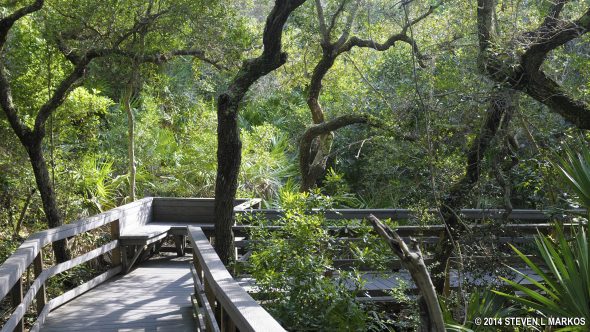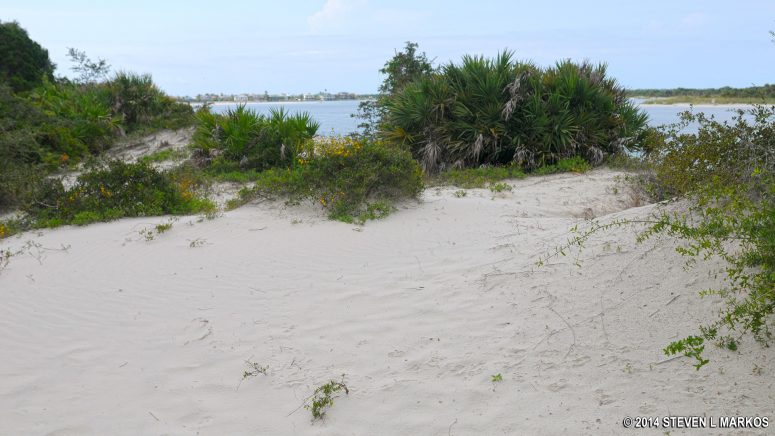Length: .5 miles loop trail
Time: 30-45 minutes
Difficulty: Easy
The nature trail at Fort Matanzas National Monument is a half-mile trail along a boardwalk that passes through a barrier island ecosystem. A free trail guide is located at the start of the trail; if no copies are available, get one at the Visitor Center. Be sure to return the guide when you finish walking the trail. There are marked stops along the way, and if you have the trail guide you can read about what you are looking at. Allow 45 minutes to walk the trail, including reading the materials at each stop along the way (30 minutes if you are walking without stopping). During the summer months, be sure to bring mosquito repellent, as mosquitoes are plentiful along the trail.
While not overly exciting, walking the nature trail is a good way to spend time if you have to wait for a Fort Matanzas Tour. It also affords a little exercise, which most everyone can use. Wheelchairs can be pushed along the boardwalk trail. There are a few very short stretches off the boardwalk through shallow sand (not like the beach), and it should be no problem for wheelchairs to cross these areas. The trail is nearly flat, so you do not have to be in great shape to walk it. As long as you can walk a half mile on flat ground, you should have no problems.
The Massacre at Matanzas is thought to have occurred in the area covered by the Nature Trail. The massacre took place in September of 1565, long before Fort Matanzas existed. The French from Fort Caroline (near Jacksonville) were on their way to attack the Spanish at St. Augustine when a hurricane blew them off course and wrecked their ships somewhere between present day Cape Canaveral and Daytona Beach. Spanish Admiral Pedro Menendez de Aviles realized that Fort Caroline must be nearly empty and therefore set out to capture the fort, which was done successfully. When he returned to St. Augustine, local Indians told him about a group of white men on the beach south of St. Augustine, so he took 50 of his men to check it out. The men were the French soldiers. They surrendered to Menendez and were marched back towards St. Augustine, but for whatever reason, once they reached the Matanzas Inlet, the Spanish decided to execute all but a few of them.
This group was not the only group of French soldiers to survive. A second group made it back to the Matanzas Inlet before also being captured. The group included the French commander, Jean Ribault. The Spanish executed all of them as well, and that was pretty much the end of the French in Florida. The French defeat is the reason that St. Augustine is recognized as the first city in the United States and not Jacksonville. The word “matanzas” means slaughter, and as oral history tells it, it is from the massacre that the inlet got its name.
With a few exceptions, use of any photograph on the National Park Planner website requires a paid Royalty Free Editorial Use License or Commercial Use License. See the Photo Usage page for details.
Last updated on April 17, 2022





